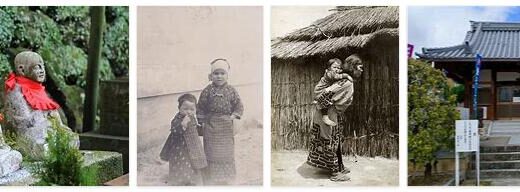Japan Population and Economic Conditions
Population
Although at the 1995 census the population of Japan had almost reached 125.6 million residents (which rose in 1998, according to United Nations estimates, to 126.6 million), in recent years the population growth has shown a further slowdown compared to the past: the birth rate, in fact, has dropped below 10 ‰ (9, 7 in 1996), while the mortality rate rose slightly (7, 2 ‰) due to the progressive aging of the population. In the territorial distribution of the residents, the evident differences traditionally present continue to manifest themselves: the deviations from the average density of the country (339 residents / km ²) oscillate between 72 residents / km ² of the island of Hokkaidō (and the values of little more elevated in the northern part of Honshū) and the several hundred residents / km ² of some prefectures in the southern part of Honshū and the southern islands of Shikoku and Kyūshū (even apart from the metropolitan area of Tōkyō, which largely exceeds 5,000 residents./km ²). The demographic imbalance between the northern and central-southern regions, therefore, not only has not cleared up, but even appears to be accentuated in some cases.
The imbalance of the settlement framework continues to correspond to a very deep inequality in the infrastructural and productive apparatus, which in turn continues to feed internal migratory flows that are anything but irrelevant. The main destination of these flows is represented as always by the large metropolitan areas, primarily Tōkyō; while Yokohama has largely exceeded 3 million residents, Ōsaka and Nagoya 2, and several other cities (Sapporo, Kyōto, Kōbe, Fukuoka, Kawasaki, Hiroshima, Kitakyūshū) the million, however it has long been evident that the ongoing urbanization in Japan does not concern individual cities, but rather a vast area ‘megalopolitan’ that embraces a large part of the central-southern section of the country, extending in length for a thousand kilometers. Within this area, due to the development of specific and complex dynamics of demographic devolution (see urbanization , in this Appendix), medium and small cities and various once rural settlements show growth rates higher than those of large cities; at the same time, it is always within this area that agricultural activities have experienced the greatest productive development and that areas of naturalistic or landscape interest are safeguarded.
Such an extraordinary and vast concentration of people and activities has required an intensification of land use, in urban and rural areas, leading among other things to a very elaborate, although substantially fragile, infrastructures (communication routes in the first place)., as was dramatically evident on the occasion of the earthquake that hit the city of Kobe in January 1995, the effects of which practically divided the country in half. Moreover, the event did not slow down the commitment in the communications sector; recent works include the Tōkyō Bay Crossing Highway (1997), which includes the two longest underwater tunnels in the world. The demographic and production concentration is even stronger if we consider that the metropolitan area of Tōkyō alone hosts the absolute majority of industrial plants and produces about a third of the country’s GDP. Basically, the intensification of the use of space took place in the area that allowed the greatest profitability of investments, neglecting any effective redistribution intervention and thus aggravating territorial imbalances.
Economic conditions
In the 1990s, the evolution of the Japanese economy, albeit still firmly in second place in the world for manufactured products and structurally very robust, underwent a more uncertain trend than in the previous three decades, with a worrying moment of stagnation in 1993 ; that this is not just a strictly economic phase would seem to be confirmed by the serious turbulence that affected the financial system of the Japan between 1997 and 1998. Primary activities continue to contract and the share of GDP due to tertiary activities is progressing very slowly compared to other advanced economies; the industrial sector therefore retains considerable importance, although it is starting to show the (often negative) effects of the restructuring underway worldwide and, in particular, in East and South-East Asia.
To a large extent, these are problems that originate in the particular characteristics of Japanese trade, which has long been ‘overly’ positive, especially vis-à-vis the United States, which insistently require measures to rebalance. Even more significant trade surpluses are recorded in relations between Japan and other, mainly Asian, countries. Membership of the WTO (World Trade Organization), the renunciation of some protectionist measures and the revaluation of the yen have actually decreased the competitiveness of Japanese products abroad and also on the domestic market. Consequently, forms of industrial delocalization to other Asian countries have been initiated (both of segments of the production cycle and of production technology) which have led to the closure of plants in the country, to the birth of import flows of goods once produced by Japan himself, to the appearance in the mid-nineties of an unprecedented, weak but significant unemployment, forms of worker mobility (also traditionally absent from the Japanese economic landscape), a reduction in social spending, increasing investments of Japanese capital in other geographical contexts. This set of processes,
As in other advanced economies, the most important aspect of the Japanese one is the growth of the financial sector: since the 1980s, the Japanese banking system for managed values has exceeded that of the United States and the Tokyo Stock Exchange is one of the main financial centers in the world (around 80 % of Japanese financial assets are concentrated in Tōkyō). The development of the financial economy and above all the external projection of Japanese capital seem to be the current and near future distinctive features, even if it does not seem plausible that the local industry (automotive, electronics and electrotechnics, optics, to mention just some of the driving sectors) is destined to contract significantly in the short to medium term.
The process of external projection of the Japanese economy is mainly exercised in the Asia-Pacific area, more or less in correspondence with what was planned by the pre-war Japanese geopoliticians as an ‘Asian co-prosperity area’ and in increasingly close competition with the United States on one side and with China on the other. The different conviction with which Japanese investments were made in Asia should also be underlined: very vigorous and long-standing in South Korea, Indonesia, Taiwan, Hong Kong, Singapore, the Philippines; much more cautious and belated in Vietnam or China.
In this perspective, several problems require a definitive solution, starting with the attitude that, both in Japan and in the countries once occupied or colonized in that same area, one continues to nurture towards the historical past, a past that still it finds more or less revisionist justifications among Japanese intellectuals and politicians, while it can only curb the willingness of other East Asian countries towards Japan. It should also be remembered the already mentioned problem of the trade deficit with respect to Japan, which already represents an element of evident dependence and induces the countries of the area to diversify their foreign trade. On the other hand, and paradoxically, a greater geopolitical commitment is required from Japan, as well as from
As in the recent past, therefore, the international position of Japan certainly appears to be guaranteed by his economic-financial pre-eminence, but more than in the past, the moment in which Japan will have to give up (and the political discussions of the late nineties seem to go in this direction) to a purely economic presence, to recover a growing share of autonomy, freeing themselves from the protective umbrella of the United States also in the military and diplomatic fields.



